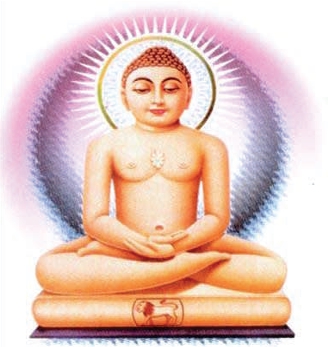
History and Doctrine of Nav Terapanth
1. Doctrine
The Nav Terapanth (New Terapanth) is the latest division within Jainism. When a harsh ascetic monastic order is supported by a wealthy commercial class laity there is the incipient danger of constant dissension and division, particularly when the ascetics attempt, as Acarya Tulsi of the Shvetambara Terapanthis has done, to reinterpret the ancient rigid tradition in response to the needs of the present generation.
The call for purity of the Nav Terapanth echoes the origin of the Terapanth sect itself over two centuries ago. Muni Chandmal in 1982 spoke for the Nav Terapanth in saying, "We have resolved not to let politics and business enter our precincts. We don't want a dictator around us so we have decided not to have an acarya-for-life" (article by Sumit Mitra, 'Jainism: Division in the Ranks,' India Today, 15 January, 1982).
This schism within the Shvetambara Terapanthis is considered as a result of criticism of Acarya Tulsi and his use of trust funds and involvement in the administration and finance of the Anuvrat movement rather than over details of doctrine of the ascetic life. For the basic doctrines which the Nav Terapanth follow, see: History of Terapanth Order and History and Doctrine of Shvetambar Terapanth .
The schism among the ascetics of the Terapanthis is a reflection of the tension within Jainism between dharma, holy law, and moksha, liberation. "The Nav Terapanth speaks out for the recurrent voice in Jainism which is constantly anxious about maintaining the absolute purity of the path of the ascetic orders, crucial to the attainment of moksha" (Oldfield 1982).
2. History
The Taranapanthi sect in the Digambaras and the Sthanakvasi sect in the Shvetambaras were sects that rejected image-worship which arose when North India was under the influence of Islam in the fifteenth and sixteenth centuries. The emergence of the Shvetambara Terapanth sect in the eighteenth century was a further attempt to purify the traditions and the ascetic orders and return to what was considered traditional orthodoxy. The Nav Terapanth has cast itself in the role of maintaining a pure tradition, free of the authoritarian power of an acarya committed to moving 'with the times.'
Satish Kumar, a former Terapanthi monk who left India to live in Wales wrote an account of his life called No Destination which supports press statements that the schism simmered for about five years before becoming public knowledge in October 1981 when a number of monks and nuns submitted their muh-patras,letters of resignation. In fact, it is clear that Kumar is writing of the late 1950's, suggesting that the roots of the schism were growing at that time.
The Shvetambara Terapanth under Acarya Tulsi launched the Anuvrat movement in 1949. To develop the movement on a national scale, trust funds were established under Acarya Tulsi's control and Jain businessmen in particular contributed generously. In attempting to present Jainism to a wider audience and make it more relevant to the needs of India and the world, Tulsi has inevitably had to compromise with the world of business and politics. Some of his ascetics and laity consider he renounced this world when he became a monk.
In 1977 Tulsi nominated his yubacarya, successor, in public. Tulsi had agreed in 1972 to nominate Muni Rupchand but in 1977 he nominated Muni Nathmal, a monk involved with Anuvrata and a biographer of Acarya Bhiksu. Muni Rupchand and his supporters complained of favouritism and said the reason for the change of nomination was that Rupchand would not support a wealthy Calcutta business friend of Tulsi. A Nav Terapanth supporter said that rich laymen wanted a pliable yubacarya to obtain contracts for them. The main criticism of Tulsi is that he has brought the Terapanth sect into disrepute by making it a meeting place for businessmen and politicians and has flouted Terapanthi doctrine by living a life of pomp and show. Tulsi claims all funds are used for humanity and he urges his opponents to "move with the times." However, press reports seem to substantiate reports that donors to the Anuvrat trusts have dubious backgrounds and that Tulsi likes extravaganza. Anuvrata-based moral education is taught in Rajasthan schools though and Tulsi has supporters in high places.
Many Terapanthis feel that the dispute is more in the nature of a clash of personalities and a reflection of a decline in the quality of the ascetic order. But the Nav Terapanth monks and Satish Kumar found Tulsi an oppressive and autocratic guru.
The dilemma of an ascetic monastic order supported by wealthy merchants is constant and attempts to change with the times makes the possibilities of schism inherent in the nature of the development of Jainism.
3. Symbols
At the diksha, initiation, ceremony the Terapanthi ascetic (and the Sthanakvasi ascetic) receives a robe, a whisk for brushing away insects, an alms bowl, and a muhpatti, mouth-shield, which are both of practical use and serving as symbols of the sect.
Terapanthis and Sthanakvasis do not worship images and they do not have a system of holy places. However, their ascetics are regarded as pilgrimage places in themselves and lay people will journey to see an ascetic. Apart from this, devotional activity is focused on bhavapuja, mental worship.
4. Adherents
A small but growing number, mainly in Rajasthan.
5. Main Centre
Rajasthan, India.